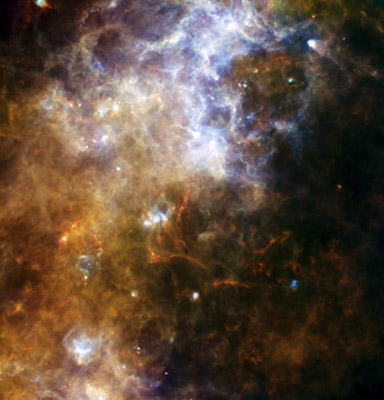Here it is – part 2 of my thesis anthology! In part one I gave a brief introduction to the protoplanetary disc, formed as a consequence of angular momentum during star formation. Next, I’ll tell you how I study these discs.This of course, is the nub of the problem for most astrophysicists – most laboratories aren’t big enough to carry out experiments on stars and planets. We therefore have two options for study:
1) We sit and watch. The Universe is a big place, and even our local neighbourhood is pretty active. This is a really good way of finding out the truth about things, but we are limited as to what we can learn – we can’t really travel very far in space, and we can only study things that happen on very short (cosmic) time scales. Still, a snapshot is better than none at all, as this amazing Herschel image shows us…
2) We turn to theory. The laws of physics are pretty well known for the systems we’re studying: we know about gravity, radiation, magnetic fields, angular momentum etc. Granted, when these different processes interact, the whole thing can become very complicated (magneto-rotational instability, anyone?).
When theory gets really complicated, then human beings find it very difficult or time-consuming to calculate the results. We must then return to computers, and conduct simulations. This is what I do.
There are two kinds of simulation I do. The first is what is called a hydrodynamical simulation. We take a gas, arrange it into a given form (the initial conditions), and then we press play. We watch how the gas responds to gravity, pressure, and radiation. The gas will evolve under the laws of physics which we put in, and we can watch what happens to our disc – does it become unstable? Does it break up into bound objects? What happens to the star at the centre of the disc? We can provide answers to some important questions about how different physical processes interact, and how stars and discs evolve towards what we see today. The simulation represents the gas by an ensemble of particles, each holding information about what is happening to the gas locally. I developed the simulation technique to better handle how the radiation is modelled by the particles – this is the most crucial component of disc physics, as it governs whether discs can become unstable and fragment as shown above.
The second type of simulation I use takes the results from what I get from the hydrodynamical simulation, and makes a synthetic image of it. This is important because real discs don’t look like what you see in the image above left, at least not when you use a telescope. Telescopes are extremely delicate, powerful tools we use to see incredible distances into the Universe, but they are not perfect. Images can be blurred by the atmosphere, or by intervening stuff in between the system and the observer. They also work better in different colours of light (or wavelengths) than others. If we want observational astrophysicists to pay attention to us, then we better do our best to emulate the problems they face when trying to observe the heavens. So, I’ve developed a way of imaging our simulations (see right). This is not easy for particle-based simulations like ours, which makes our work a very useful piece of software development.
This is an image of what the next generation of telescopes might see if they look at a star with a single fragment forming around it. Before, we would not have been able to see the spiral structure forming in the disc, but our work shows that maybe in the future, we will.
So, that is a (very) short introduction to the experimental techniques I use as part of my thesis. Next time, I shall show you some of the science I have done with these methods.



One thought on “Thesis Anthology Part 2: How do I do what I do?”